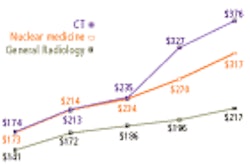When organized radiology established a new radiologist assistant (RA) position earlier this year, radiologic technologists won new opportunities for additional recognition and career advancement. But many RTs are already performing advanced-level tasks even without the RA designation, according to a survey presented at this week’s 2003 American Healthcare Radiology Administrators conference in Anaheim.
Such responsibilities range from obtaining written consent from patients to providing physicians with unofficial (and in some cases very discreet) image interpretation, according to Rebecca Ludwig, an assistant professor at the University of Arkansas for Medical Sciences in Little Rock. Ludwig believes the findings demonstrate that RT educational programs need to do a better job of preparing technologists for job responsibilities that aren’t currently in the educational curricula.
Ludwig said she conceived of the survey due to a nagging sense that RT programs weren’t preparing RTs for the real world. "The things that we want them to do on a regular basis may not be the things they are prepared to do," Ludwig said. "I wanted to look at gaps between the educational process and the realities of the workplace."
Ludwig developed a random sample of 5,000 RTs, drawn from a list of technologists registered with the American Registry of Radiologic Technologists (ARRT) of St. Paul, MN. She then created a questionnaire with 42 items.
In addition to questions about job responsibilities, the survey asked the respondent’s location, the size of their hospital or imaging facility, and how often a radiologist was present when they were working. The response rate for the April 2002 survey was just over 41% (n=2,062).
Ludwig divided the answers into several categories based on the number of respondents who said they performed the surveyed duties. Three types of job responsibilities were performed by over 60% of the respondents:
- Obtaining consent (79.8%)
- Training new RTs (73.3%)
- Injecting contrast (68.9%)
The next group of answers involved response rates between 40%-60%:
- Inserting IV lines (56.2%)
- Performing patient education (53.4%)
- Handling document compliance (45.8%)
- Taking spot images (45.1%)
The next category included duties performed by 20%-40% of respondents:
- Performing fluoroscopy (36%)
- Providing continuing education (28.9%)
- Performing EKGs (23.1%)
- Handling stitches and bandages (22.7%)
- Conducting physical exams (20.2%)
Tasks with less than a 20% positive response included changing casts, inserting urinary catheters, monitoring sedation, handling lab tests, injecting medication, conducting research, and interpreting EKGs.
Unofficial image interpretation
One potentially controversial job duty was unofficial image interpretation. Overall, just over a third of all respondents (34.7%) said that they or someone in their facility has provided unofficial image interpretation for radiologists. There was little difference in responses to this question based on the clinical setting: 27.9% of those in trauma settings said they or someone they know have unofficially interpreted images at some time, while 27.1% of respondents in non-trauma settings answered affirmatively. Only 21% said unofficial interpretations had taken place during off hours.
Ludwig said the survey probably underreports the percentage of RTs who have conducted unofficial image interpretation, due to the controversial nature of the topic and the comments she received from those who answered affirmatively.
"I think they were admitting this with great reluctance," she said. "They know that this is not officially their job, and that they do this unofficially. If I can get a third to admit to this, there are probably more who did not want to go that far."
What kind of RTs have provided unofficial reads? In general, they fit the image of an RT in a smaller hospital with gaps in radiologist staffing. Responses were higher among RTs at hospitals with fewer than 100 beds, and at sites where a radiologist was present less than 20 hours a week. But it also happened at larger institutions and at those where radiologists were more readily available, Ludwig said.
Drawing conclusions
Ludwig acknowledged that many RT programs might be teaching technologists the more advanced responsibilities covered by the survey. But there’s no nationwide curricula or competency assessment program to ensure that technologists are performing these tasks at an adequate and nationally uniform level.
"I really feel a formal process would better serve our patients’ interest," she said. "If RTs are doing this, let's have a formal mechanism to make sure they are doing this to our patients’ benefit."
Should such topics be taught as part of an advanced-level RT course, such as an RA or radiology practitioner assistant (RPA) program? Or should advanced training be incorporated into the basic RT curriculum?
That decision should be up to individual programs, Ludwig believes. But her opinion is that basic RT programs already have their hands full training future technologists in the basics of their job.
"There are only so many hours in the day and there is only so much that you can give entry-level RTs," Ludwig said. "I think we need to be consistent and have an advanced core curriculum that is uniform regardless of the degree that we award to it."
By Brian CaseyAuntMinnie.com staff writer
August 15, 2003
Related Reading
New radiologist assistant position promises career boost for RTs, May 30, 2003
Survey reveals pay and perks for radiologic technologists, May 29, 2003
Breast center enlists radiographers for first look at mammograms, March 11, 2003
ASRT fund issues grants for RA programs, February 3, 2003
RTs score well in breast imaging classification, January 22, 2003
Radiology extenders -- the answer to the RT personnel shortage?, September 9, 2002
ASRT offers creative solutions to stem RT shortage, July 30, 2002
Copyright © 2003 AuntMinnie.com



















